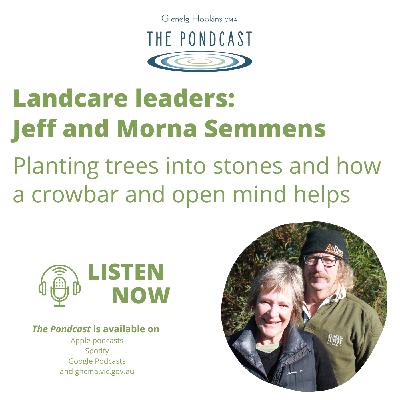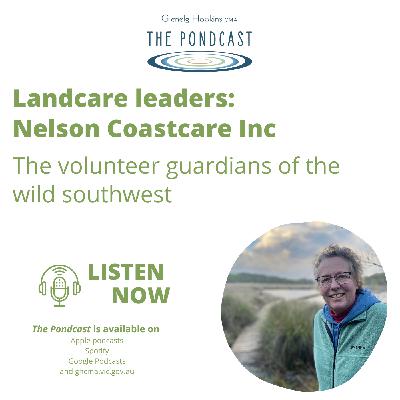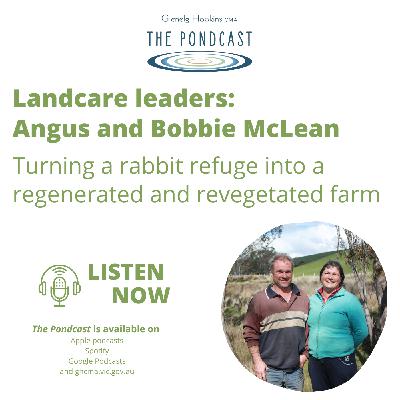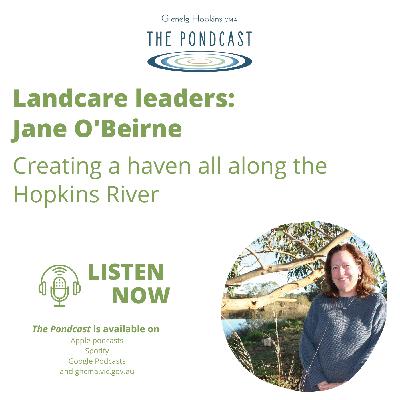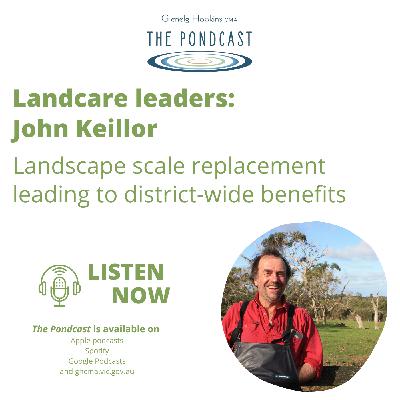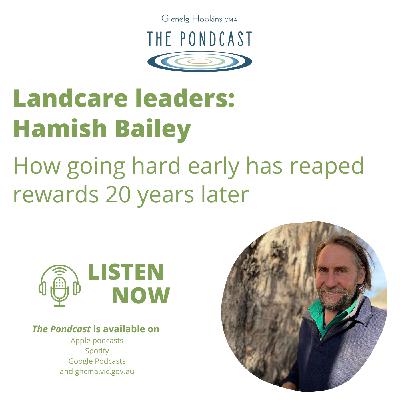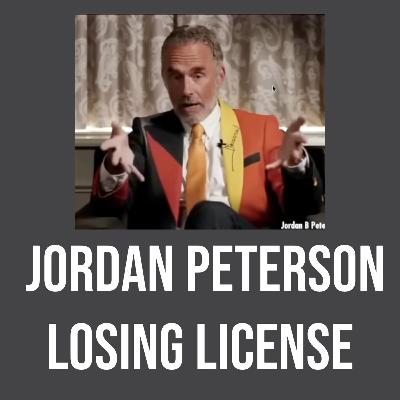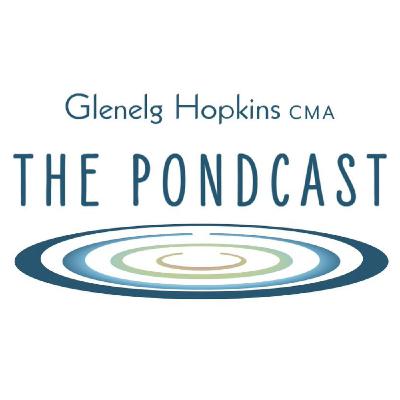Discover The Pondcast
The Pondcast

The Pondcast
Author: Glenelg Hopkins CMA
Subscribed: 2Played: 281Subscribe
Share
© Copyright 2021 All rights reserved.
Description
In this series, we take a look at what a Catchment Management Authority does, a few of the projects the organisation is delivering on the ground, meet some of the passionate people working to deliver those projects and hopefully along the way, give you an insight to how we are protecting and enhancing the land, waterways and biodiversity of the Glenelg Hopkins Region of South West Victoria.
20 Episodes
Reverse
Glenelg Hopkins CMA Landcare Leaders series
Jeff and Morna Semmons
Planting trees in stones and how a crowbar and open mind helps.
Morna and Jeff are first generation farmers, who bought a stony block of land covered bracken that had winds that blew from one end to other with the aim of giving their children a grounded upbringing. 30 years later, they have become local leaders in Landcare who drove the need for a local facilitator of works, experts in all sorts of techniques to get trees to grow in a challenging landscape – including using a crowbar – have a crop-producing of Wattles plantation, and created a productive farm landscape which leaves a sustainably legacy for the future.
Glenelg Hopkins CMA Landcare Leaders Series
Nelson Coastcare Inc - Mary Styles
In this episode, we meet Mary Styles from the Nelson Coastcare Inc group from the far south-west corner of Victoria west of Portland.
Mary and her merry band of over 40 volunteers are the guardians of the Ramsar-listed wetland area of Long Swamp and the Glenelg Estuary. She declares it the last wilderness frontier in Victoria and the crew from Nelson Coastcare take their responsibility for caring for, understanding, monitoring and mapping of the area in a variety of ways but with the common goal of protecting it for future generations and for the benefit of the environment and tourism in the local area.
For those wanting to download the Nelson Coastcare audio information, its available at nelsoncoastcare.org
Glenelg Hopkins CMA Landcare Leaders series
Angus and Bobbie McLean, Pigeon Ponds
How a rabbit refuge became revegetated and regenerated
When Angus McLean and his wife, Bobbie, moved back to the Pigeon Ponds district in 2014 and purchased a farm hosting almost the entire population of the region’s rabbits, they could not have realized how much change they could influence on a property in just 12 years through fencing, revegetation and regeneration. With a new bridge, watering system that lifts water almost 80 metres up hillsides, and a creek area that is now an abundance of regeneration, the McLeans are now farming in an environment that is safer, healthier and more productive than ever.
Glenelg Hopkins CMA Landcare Leaders series
Jane O'Beirne, Hopkins River, Warrnambool
Creating a Hopkins River haven for all
For the last 25 years, planting sections of the banks of the Hopkins River has been Jane’s goal – bit by bit joining the sections together form the Hopkins Falls all along the length of her farm to replace what was once removed. To get the 2000-odd trees a year into the ground, Jane has called on the community, utilizing family, neighours, and school groups to ensure the plants get into the ground so they can begin looking after themselves. It’s paying off in more than just improved production on-farm, the waterway is healthier too, as evidenced the platypus who appear at the end of this interview!
Glenelg Hopkins CMA Landcare Leaders series
John Keillor, Cashmore Park, Portland
Putting back what was once there across the landscape
In John’s family, the connection to environmental support through field naturalism goes back to the 1900s, and grazing on some of his property has the longest in the history of Victoria, going back the very first settler farmers in 1834. And about 30 years ago, John started his own impact on the local landscape when he headed up the Tarragal Landcare group which took a landscape-scale approach to reversing the clearing of vegetation in the local area. From planting north-south corridors of vegetation, to espousing the benefits of local landcare facilitators, John’s history with landcare is strongly rooted in the theory of living on and with the land.
Glenelg Hopkins CMA Landcare Leaders series
Hamish Bailey, Park Hill, Wannon
How going hard early is paying dividends 20 years later
By his own admission, Hamish Bailey went hard early when he returned to the family farm 20 years ago with his fencing and revegetation works. It’s something he now looks back on with pride because he can see the benefit of that investment of time and effort on the banks of the Wannon River, across the visual landscape of his farm and in the win-win situation he finds himself with a more productive farm and increased biodiversity. It’s also given him the knowledge that the trees he continues to plant today, will be worth it in generations to come.
Glenelg Hopkins CMA Landcare Leaders series
Peter and Jo Armstrong
How treeplanting led to a conservation mystery at Curra
In this episode, we meet Peter Armstrong, who with his wife Jo, runs a mixed farming operation north of Streatham in south-west Victoria.
30 years ago, Peter and Jo began planting trees on their farm to try and deal with salinity issues in their gully areas. Since then, they’ve planted between 250 and 1000 trees a year and seen an improvement in the land’s health and diversity of animals they see on the farm, but it has also meant an odd saline issue has raised its head!
We are back out on the Tyrendarra flora reserve with Robin Adair controlling Italian Buckthorn.
This introduced exotic plant is playing havoc in the reserve, and as Robin points out in this episode, managing takes some integrated solutions – herbicide is one, but fire might be one of the best.
On a drizzly windy spring day, we found members of the Friends of the Forgotten Woodland on a roadside, planting banksia, sheoak and sweet bursaria plants. They were establishing a new seed orchard to ensure the remnant native vegetation will always be in the landscape of the Victorian Volcanic Plains.
The group GPS plots and note the provenance of every tree they plant, which is how they know on this day, they planted a plant which is had genetically been on the plains for hundreds of years.
Italian Buckthorn - the woody weed with tasty red berries is beginning to encroach on our landscape. In this episode, Glenelg Hopkins CMA's Tania Parker is our in the field with expert Robin Adair and his offsider Kym, discussing how to control this entirely unpalatable introduced species.
In this episode we are out in the grasslands tossing golf balls into quadrats with researchers from the Arthur Rylah Institute.
Brad Farmilo loves talking grassland ecology, and he’s passionate about the projects being undertaken not just ticking boxes about how many kilometres of fences have been put up or plants planted. Instead, he is all about creating and providing useable and useful information and data for land holders, land managers and the people making the decisions about investments to make sure practice change doesn’t just happen at grass level, but also at policy level.
In this episode we meet Victorian Landcare Awards Australian Government Individual Landcarer Award winner Don Rowe, from Maroona.
This award acknowledges the significant contribution made by an individual who has demonstrated outstanding leadership and commitment to Landcare.
Don Rowe is a local landholder, community member and leading Landcarer in the Upper Hopkins area around Ararat. He has been involved in the Landcare group since it began 30 years ago, but even before the Landcare group was formalised, Don was actively carrying out Landcare work on his own property, transforming it from windswept paddocks to an agricultural landscape with biodiversity corridors and land class fencing.
As a school teacher – he was also pretty quick to get kids out into the paddock planting trees to begin the education about the importance of Landcare early … and now, most exciting for his grandkids – he has a trophy for tree planting.
But his key message to other landholders is: just start planting.
In this Pondcast we are talking all about bitterns. We talk to project manager Jacinta – who explains the project behind finding the elusive Australasian Bitterns. These shy, long-necked birds who sway with the rushes, fly south for the winter each year from the NSW rice fields. And meet siblings, Riley and Macey from Portland, who noticed a weird noise coming from the swamp at the bottom at their garden, and for the last couple of years, they’ve been actively reporting and recording them for the CMA project.
Find out why the coastal area of south-west Victoria is so internationally important, not just for its geologically significant wetlands, but also for the role it plays as a round-the-world holiday destination for a group of birds from Siberia.
Glenelg Hopkins CMA's Glenelg Estuary Discovery Bay Ramsar site coordinator, Gavin, takes us for a wander on the sand dunes and around the wetlands.
Native grasslands on roadsides are often driven past without a second thought, but a passionate group of people are taking an active role in restoring these endangered plant communities and having great success balancing the ecological, community and agricultural values of the region.
Soil used to be seen as the enemy in natural resource management (NRM), and there was once a great divide between the farming community and those authorities who sought to improve the environment. But things have changed - and now agriculture and NRM can work hand in hand for beneficial outcomes for everyone - with Richard taking care of the admin.
We met the dynamic duo getting stuff done along the waterways of the Glenelg Hopkins CMA region – Steve and Alex. These two are responsible for putting things IN the river, like fish hotels and ladders, delivering environmental flows along the waterways, and probably most importantly, talking to people about the river and engaging with the communities along it.
Meet Jarred, the man with the job of trying to manage the competing needs of our environment where the river meets the sea. Managing coastal estuaries with the competing needs of the environment and the community can be tricky, but he also gets to spend a lot of time outdoors in some pretty spectacular environments, learning from traditional owners, helping landholders and working with community and school groups.
We sit down with Aggie and Ben, the Glenelg Hopkins CMAs natural resource management planners in the Biodiversity team who are charged with protecting an area known as the VVP. We learn how locking up and leaving native grasslands is the worst thing you want to do if you want to actually look after them, and why they’ve been clocking up the kilometres playing cupid to an oddly named little yellow flower.
The Glenelg Hopkins CMA protects and enhances the land, water and biodiversity across about 26,000ha of Victoria's south-west. But, does anyone really know what GHCMA stands for? In this episode, we meet Adam Bester, the CEO of the Glenelg Hopkins CMA and ask him what his organisation does, how it does it, who funds it, and who does all the work.


